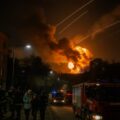
Why Most Ukrainians Abroad Are Not Returning: A Deep Analysis in Year Four of the War
Year four of the full-scale war. Millions of Ukrainians remain abroad — and what once sounded like temporary displacement now feels increasingly permanent. In 2022, they left with a plan to return. In 2025, that plan is quietly fading. Not out of betrayal. But out of life moving forward — in new places, with new rules. And for Ukraine, the silence around their return is the real danger.
Over 5 Million Ukrainians Remain Abroad
According to official data and research by the Center for Economic Strategy (CES):
- Over 5.2 million Ukrainians were living abroad as of late 2024.
- 443,000 people left Ukraine in 2024 and did not return — triple the number from the previous year.
- In total, over 3 million have not returned since the war began.
This is no longer a temporary migration wave.
This is a structural shift in Ukrainian society.
What They Say vs. What They Really Plan
Sociologist Oleksiy Antypovych explains the discrepancy:
“When asked directly, many Ukrainians abroad say: yes, we want to return.
But as soon as you ask when, under what conditions — their answers begin to change.
You realize they’re already building a life elsewhere.”
CES surveys confirm this:
- 43% say they are considering returning.
- But only 20% are certain they actually will.
- The majority remain undecided — or already integrated abroad.
This isn’t about loyalty. It’s about survival, security, and stability.
Why They Stay: Not Because They Forgot Ukraine, But Because Life Continued
Common reasons cited by displaced Ukrainians:
- Safety: many fled from areas still under threat.
- Destroyed homes and infrastructure: nothing to return to.
- Jobs and income: Western Europe offers more stability.
- Children’s education: already enrolled and adapted to local schools.
- Bureaucracy fatigue: reentering Ukrainian systems often feels daunting.
To ask them to “return” is asking them to risk not just their future — but their children’s stability, too.
Revelant
Who They Are: Not One Group, But Four
According to CES typology, Ukrainians abroad fall into these categories:
- Patriots (28%)
Emotionally tied to Ukraine. 86% say they will return. But many are older, or still struggling abroad. - Classic Refugees (22%)
Mostly women with children. Highly sensitive to security — they will only return when peace is guaranteed. - Quasi-Labor Migrants (25%)
Adapted quickly, found work, integrated into host societies. Most have no plans to come back. - Frontline Displaced (26%)
From areas like Donbas or Kherson. Deeply affected, but many have no home left to return to.
Each group has different needs. And none will be convinced by slogans alone.
Can They Be Encouraged to Return? Yes — But Only Through Action, Not Appeal
So far, Ukraine has no comprehensive return strategy. No roadmap, no coordinated policies, and no real public narrative beyond vague hope.
What would help?
- Targeted reintegration programs: offering jobs, housing, education.
- Real safety assurances: beyond just “the war will end someday.”
- Respect for their new identities: they are Ukrainians, even if their kids speak German or Polish now.
- Clear, transparent communication: no guilt trips, no shame — just options and support.
The Question Is No Longer “When Will They Return?”
It’s “Will Ukraine Give Them a Reason To?
These people didn’t abandon Ukraine. They just moved forward — because life demanded it.
Now the challenge is not just to bring them home.
It’s to create a version of Ukraine they would want to return to.
One that offers not just memories — but a future.
Not just patriotism — but purpose.
Because they’re not gone.
They’re watching, working, waiting.
And the silence they hear from home… is louder than ever.















